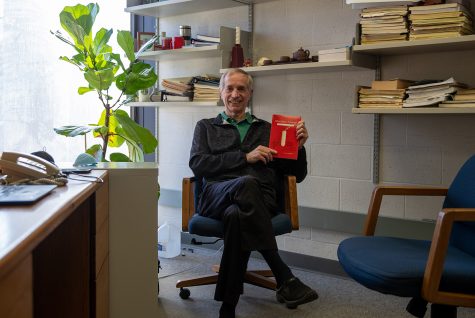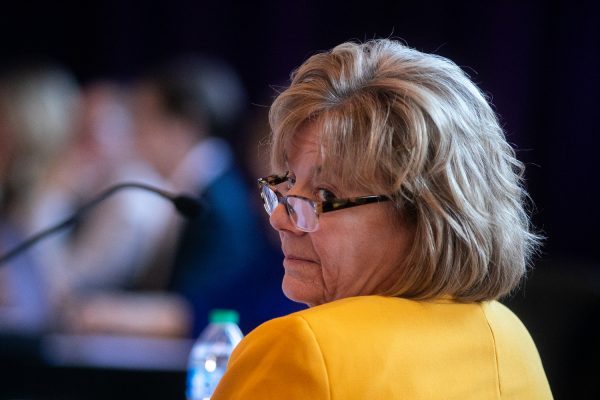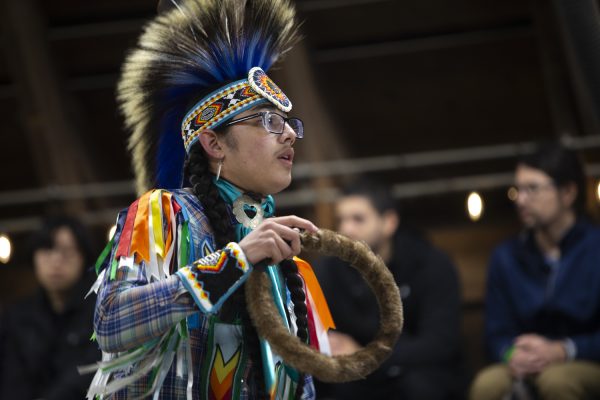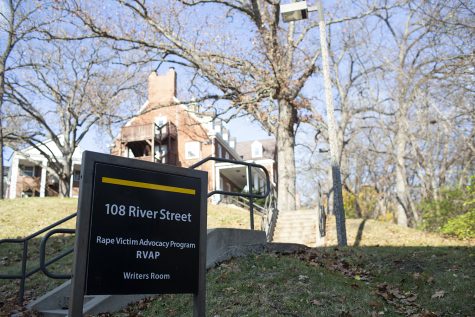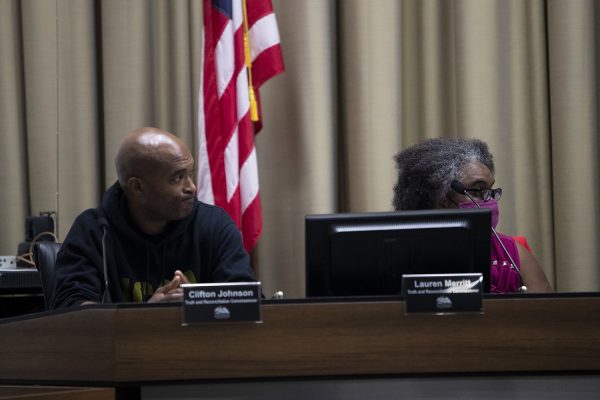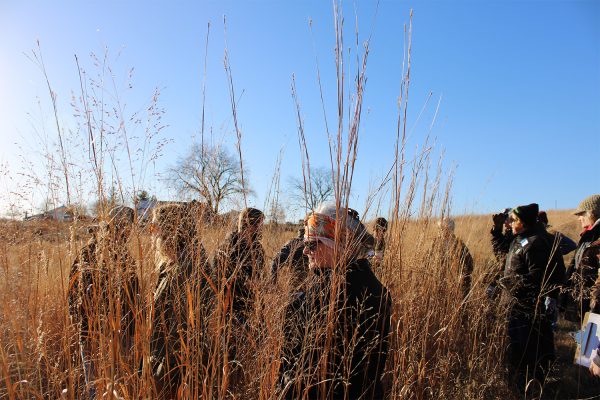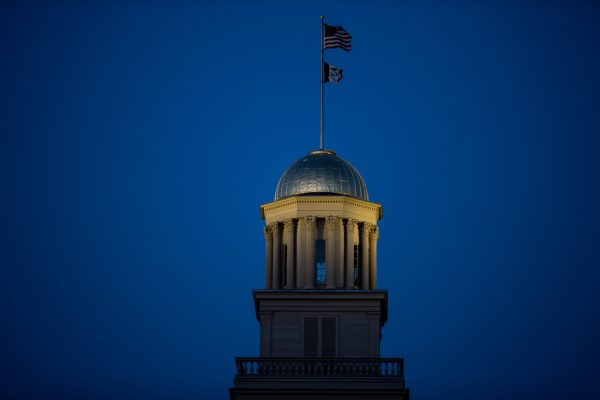Experts say refugee numbers in Iowa will gradually increase under refugee ceiling increase
The U.S. is expected to allow more refugees under the Biden administration, and experts say Iowa is expected to see an incremental increase in the number of refugees resettled across the state.
Democratic presidential candidate Joe Biden speaks during a Biden drive-in rally on Friday, Oct. 30, 2020 at the Iowa State Fairgrounds in Des Moines. Around 200 cars parked on the grounds and a few people gathered at the front as Biden commented on a change in the presidency and promised to address issues with public health due to the Coronavirus.
March 8, 2021
President Biden’s proposed refugee ceiling will increase the number of refugees resettling in Iowa, however experts say this will be gradual as state and local agencies rebuild and receive more funding.
The presidential determination for the number of refugees allowed in the U.S. has been declining since the Trump administration took office, dwindling from 110,000 in fiscal 2017 to 15,000 this budget year.
Biden has discussed plans to raise the number of refugees allowed in for this cycle to 62,500 and set the cap at 125,000 for fiscal 2022.
In 2018, 383 refugees resettled in Iowa, a decline from previous years due to the Trump administration’s tightening of limits and regulations on the refugee resettlement process.
Mak Suceska, bureau chief for the Iowa Bureau of Refugee Services and the state of Iowa’s refugee coordinator through the Office of Refugee Resettlement, said the effect of Biden’s refugee plan on the bureau’s work will depend on the number of refugees the state receives and the type of infrastructure the bureau will need to rebuild.
The national number of refugees being tentatively released has started local and statewide conversations about preparation for the next wave of refugee resettlement, Suceska said.
When the presidential determination lowers, it in turn decreases the amount of funding resettlement receives. Then, Suceska said, it’s a matter of seeing how those gaps can be filled in and how to home in efforts to support newly arrived refugees.
Each population and community has its own challenges and successes, Suceska said. The bureau works toward addressing those gaps and barriers to help empower and uplift refugees and support their new life in central Iowa and across the state, he said.
“It really will be incumbent upon what sort of infrastructure we have, what sorts of concerns or barriers people are coming with to the state, and how we are addressing that as a society,” Suceska said. “That would bode well to foster that certain growth and opportunity that we are all entitled to in a sense, but mostly our most vulnerable.”
Suceska said the bureau has received steady funding throughout the years but increased numbers will affect resettlement agencies.
The influx will not be right away, Suceska said, as of right now the cap for 2021 is still that set by the Trump administration.
Looking forward to 2022 and subsequent years, Iowa will see more of an incremental increase in the level of refugees that are going to be resettled in Iowa and across the country, Suceska said.
Suceska said the resettlement process is going to depend on a state and community’s capacity to accept increased numbers.
“It’s definitely on the horizon,” Suceska said. “We just have to be more intentional and more strategic in how we navigate all of these different nuances and what’s yet to come.”
Suceska, originally from Sarajevo, Bosnia, said he arrived in Des Moines as a refugee in August 1993.
Given the new administration and new immigration policies, Suceska said Iowa and the U.S. as a whole may see an uptick or changing of new demographics coming to the state.
“We just have to really be prepared [and] work together as a community collectively to help receive the folks that we’re going to be supporting,” Sucseka said.
Dating back to its inception of resettlement in 1975, Suceska said, Iowa has always been a welcoming place for refugees.
“From a personal perspective, I think Iowa definitely has a lot to live up to its legacy,” Suceska said. “I think throughout the years of resettlement and refugees coming to Iowa, everybody who has been in office or has held any sort of political position from the governors to mayors to local leaders, there’s always been a consensus across the aisle in supporting refugees and immigrants.”
Sara Zejnic, director of refugee and immigrant services at the Catherine McAuley Center — which resettles populations within a 100-mile radius of its Cedar Rapids office — said the number of refugees the agency resettles is directly related to the presidential determination that is set every year by the president, in consultation with Congress.
“Different administration’s priorities impact the number of refugees that we are able to resettle,” Zejnic said.
The center, which is an affiliate of the U.S. Committee for Refugees, provides core resettlement services to refugees during their first 90 days and beyond in the U.S. through reception and placement, Zejnic said.
The center is paid per capita, Zejnic said. So, when the number increases, the center receives additional funding that can be used to hire additional staff to meet increased needs, she said.
“We believe that refugees and immigrants add value to the communities that they’re in,” Zejnic said. “They bring diversity — they bring economic impact. And we appreciate and welcome new members of our community.”
Iowa is a hub for secondary migration, Zejnic said, especially Eastern Iowa because of the cost of living, its education system, and friendly community.
“We’re supportive of those that recognize the humanity of people and the needs that people in this country have to be successful,” Zejnic said. “And we know that our community is enriched by refugees and immigrants and we are supportive of anything that helps people get the resources that they need to identify that stability and skill building that helps them be successful members of our community.”
Stephanie Moris, director of the Refugee Alliance of Central Iowa, said because the Trump administration’s presidential determination was so low, there have not been as many refugees coming into Iowa.
Even though the Biden administration has set a higher presidential determination, the increase will be slow, she said, as agencies need to rebuild their internal infrastructure and adhere to COVID-19 and travel restrictions.
“When you lower the number of people coming in to be resettled, you’re defunding those agencies as well,” Moris said. “Any change to resettlement changes secondary migration.”
Moris said refugees in Iowa have contributed to economic revitalization across the state, especially in small towns, as they fill meatpacking and manufacturing jobs.
According to the American Immigration Council, immigrant households in Iowa paid $859.2 million in federal taxes and $521.8 million in state and local taxes in 2018. Additionally, they had $3.9 billion in spending power.
Moris added that refugee resettlement is good for the state and Iowa’s economy, and has helped small towns survive.
“The topic of refugees and immigrants have never really needed to be as political as they are,” Moris said. “These communities have really carried our state through an entire year of a pandemic.”





